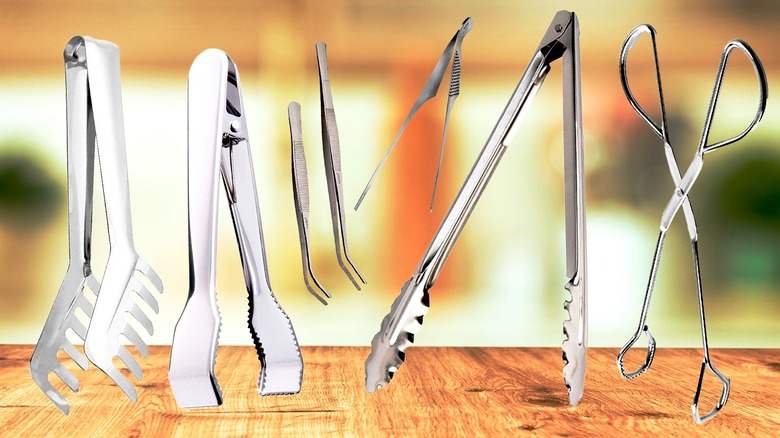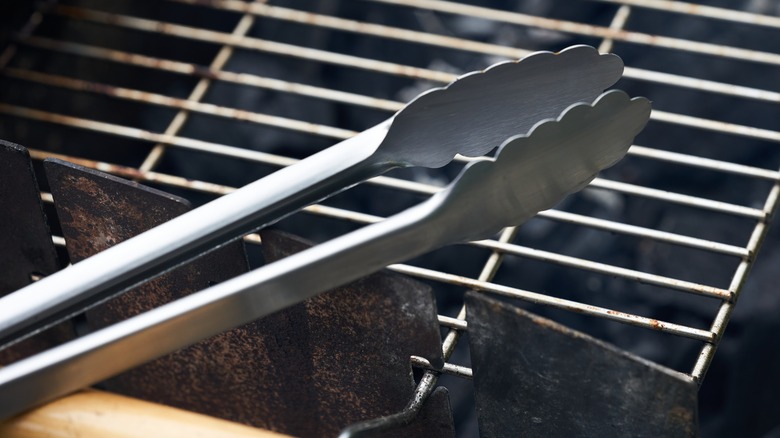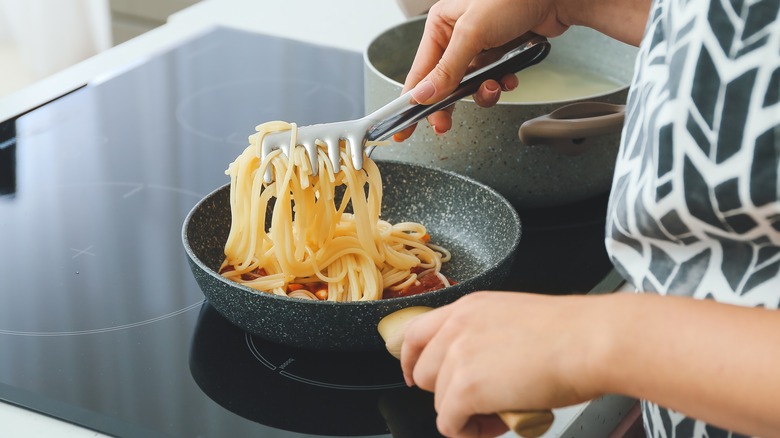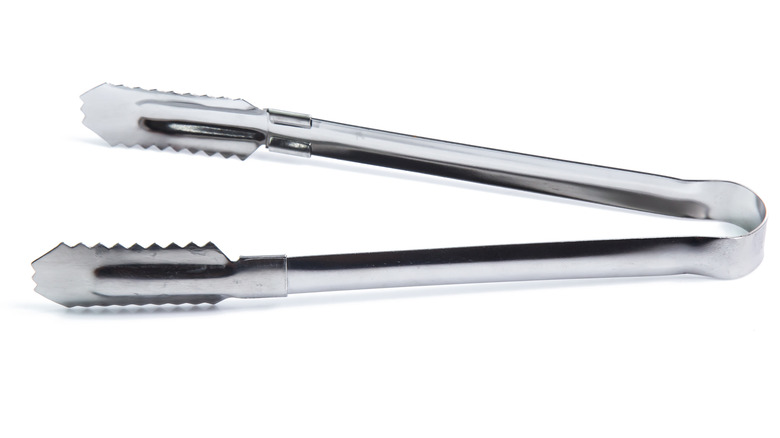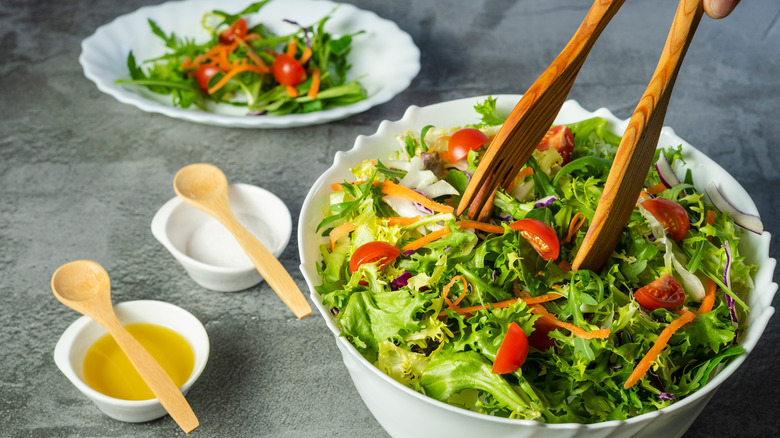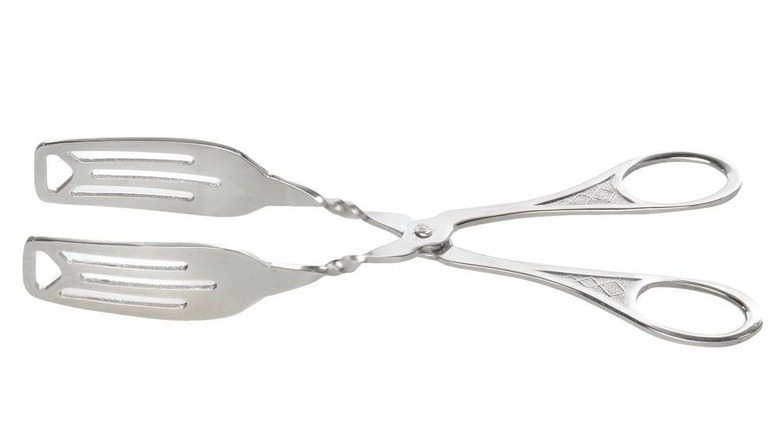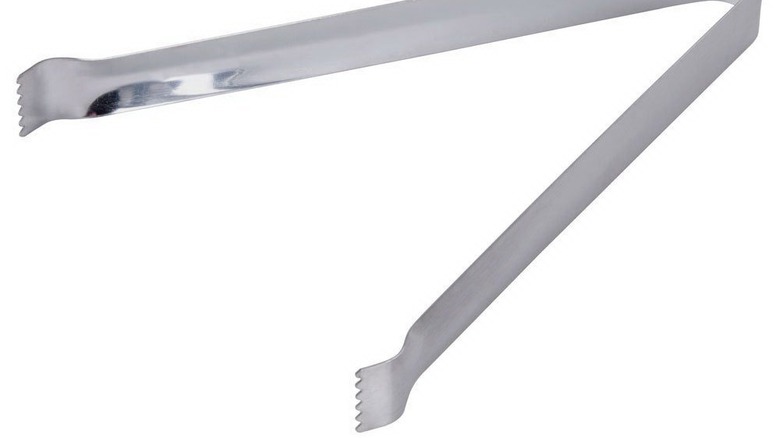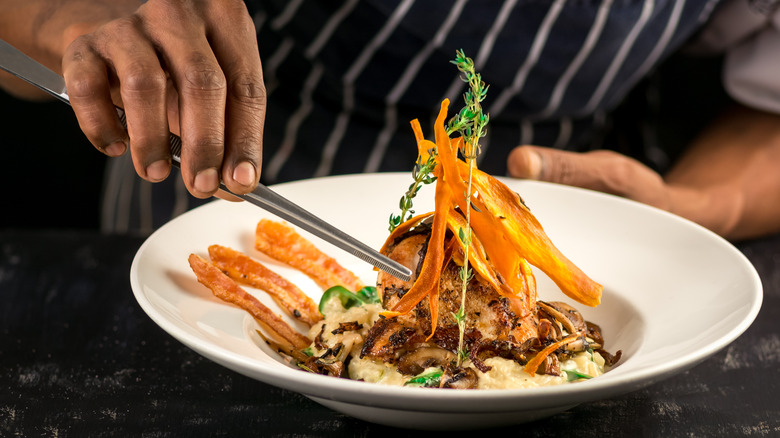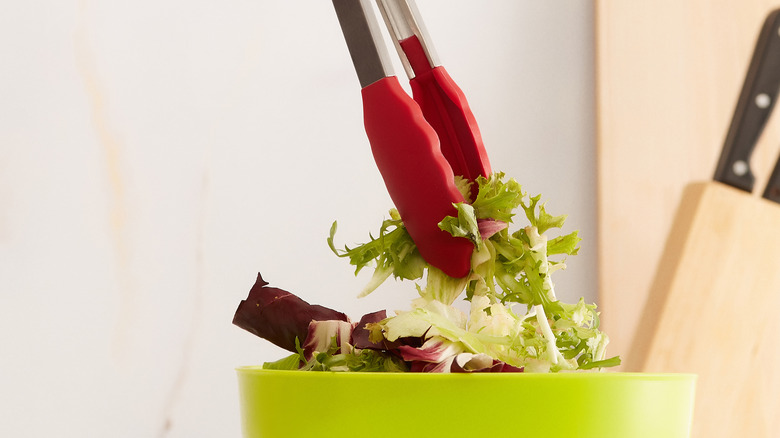11 Types Of Kitchen Tongs, Explained
If you were to look in your kitchen cabinets, how many pairs of tongs would you see? One? Maybe two? That's all that you need, right? Sure, you probably know there are more kinds of tongs out there, but maybe you've never actually stopped and thought about it. The fact of the matter is, there are some rather unique tongs out in the kitchen wild that will actually make your culinary experience so much easier.
So instead of one day finding yourself wandering the utensil section at Williams-Sonoma because it's the only thing you can afford with the $50 gift card someone gave you and marveling at the unique tongs you've never imagined before, you'll know exactly what those tongs are for, and how they can improve your life. Because yes, it's true there are countless kinds of kitchen tongs out there, and it's not a marketing gimmick from the tongs people. Much like sitting down for dinner in a royal palace where there are a dozen spoons on one side, each set of tongs has a unique function. Some of these functions might just blow your mind at how much easier they make certain tasks around the kitchen.
To help illustrate just how many kinds of kitchen tongs there are, here are some of the tongs you'll run into, and some you might want to consider adding to your kitchen. However, we can't promise you that they'll be cheap enough to buy with that Williams-Sonoma gift card.
1. Utility tongs
Chances are, these are the tongs you have in your kitchen. They are on the longer side, which makes it easier to grab and dish up just about anything you have in front of you. The ends are curved and spoon-like. Utility tongs are the go-to tongs in most instances, and if you only have one set of tongs in your kitchen, this is probably the way to go.
Most utility tongs will have what is known as a scalloped edge to the spoon-like end (it kind of looks like how you'd draw your fluffy clouds back in grade school). The scalloped end does make it easier to pick up certain items, such as some kinds of pasta, but because it doesn't fully commit to being a set of pasta tongs (more on this later) it doesn't work as well.
In general, you can get by with most of your cooking using utility tongs, and because there are so many uses for them, the size range will vary from half a foot to nearly a foot and a half in length. Many grocery stores and kitchen appliance stores sell a number of utility tongs sizes. These kinds of tongs can be made from either food-grade plastic or stainless steel.
You will also find locking utility tongs. Locking tongs are spring-loaded in the middle and when activated will shorten the opening width of the tongs. This makes the tongs great for storage and for picking up slender objects.
2. Pasta tongs
If there is any pair of tongs we can't recommend enough for you to own, it's a pair of pasta tongs. If you're like us, you love yourself some pasta, but that also means you have to try to scoop the spaghetti out of your pot. Ever try to do that with regular tongs? Like trying to grab an oiled pig. Those things just squeeze and flop out of your regular tongs' grasp. But pasta tongs? Those things are pure magic. We probably make more pasta than anything else that requires tongs, which is why we can't get enough of these little helpful utensils.
So what makes pasta tongs so special? It's the little, finger-like extensions on the edges of the tongs. They basically look like a hair clip (especially when it is clamped down around some steaming angel hair pasta). Those finger claws do all the work.
Most pasta tongs are made from stainless steel. The most basic will have the standard "V" design of the tongs, which is rather universal with tongs, regardless of the type. This is better known as a one-piece construction. You can, though, find cheaper plastic options, or even spring-loaded locking pasta tongs. We recommend going with metal tongs over plastic. Yes, plastic will be cheaper, but plastic has a way of wearing down, which can give you limp tongs. Not to mention, they just don't look as pretty as sparkling stainless steel.
These kinds of tongs will also vary in length, although most will usually be around a foot or so in size. You don't need too much material slack when grabbing some pasta.
3. Serving tongs
These are similar to utility tongs, although they are usually shorter and the ends are smoother, allowing you to plate and serve just about anything without causing damage. Serving tongs are basically the glamorous sibling to utility tongs, in that they are designed to be shown off. If you've ever been to a restaurant, or possibly a catered wedding, where the tongs next to a dish are a bit more elaborately decorated than your tongs back home, then you've used serving tongs before.
Serving tongs are still made with the one-piece construction, which makes them easier to wash (which is important to catering companies, as they will have a large number of tongs to clean at the end of the event). The tongs are almost always made from stainless steel and might have some kind of decorative finish on them. Sometimes this is a subtle texture pressed into the metal, or there might be cutouts within portions of the tongs. Essentially, they are functional utility tongs with a bit more pizazz to them.
The tongs range in length from around half a foot to 14 or 16 inches. If you're considering serving tongs, you'll want to think about not only what you plan on serving with the tongs, but where you will store them. There's nothing worse than buying a new kitchen utensil only to discover it's too long to fit in your kitchen drawers.
4. Salad tongs
What comprises salad tongs? One side will be a spoon, while the other will be a fork (or possibly a spork). This way you can toss, grab, and serve up leafy greens, no matter what you have tossed in the bowl.
These tongs are generally made from food-grade plastic, but some nicer ones might be made of wood. This way, they are easy to maintain, and the acidic nature of some salad dressings won't eat away at it, which might be the case with certain metals. There are also different kinds of grips for these salad tongs. As most salad tongs have one-piece construction, there are no additional moving pieces on the tongs, making them very easy to maintain and clean.
On the flip side, if you're looking for something a bit more elaborate, you can also find scissor-handled salad tongs. This handle very much looks like an oversized pair of scissors, only it gives you a better grip and usually comes with a longer handle. This is good if you are serving up a salad to guests in your home and you want to extend your reach. In general, though, you'll probably be just fine with the inexpensive plastic salad tongs, which range anywhere from half a foot to a foot.
5. Grilling (BBQ) tongs
These are essentially longer versions of utility tongs. The design is nearly identical. The main difference is the tongs are significantly longer. Because you're working over flames, BBQ tongs can extend close to 2 feet, which should give you plenty of space to work with.
Before going out to purchase a pair of BBQ tongs, we recommend considering the size of your grill. If you have a smaller, portable grill, you probably don't need the giant 2-foot BBQ tongs. Tongs become an extension of your arms when in use, and it is possible to have too much of an extension for the task at hand. Instead, these tongs should allow you to reach the back of your grill without placing your hand directly above the cooking surface. So the larger your grill, the longer your tongs.
As the tongs are on the longer side, they usually abandon the one-piece construction. The extended tongs as well as the weight of the meat and veggies you're picking up from the grill place too much tension at the curve of one-piece tongs. That is why these are usually made from a two-piece construction with the individual pieces riveted together. It ensures you have a sturdy pair of tongs that can take the heat. Many BBQ tongs will also have a rubber grip to help protect your hands from heated steel, making them perfect for handling any kind of regional BBQ you might be whipping up.
6. Ice tongs
Ice tongs are typically made out of stainless steel (or aluminum). They are also some of the smallest tongs on the market. These particular tongs have spike edges, resembling Bart Simpson's head or a chicken's foot more than anything else.
The ice tongs are on the smaller side, ranging from around 5 inches all the way up to 9 or 10 inches. You don't need long ice tongs as you need just enough room to pick up a cube of ice and place it into a glass. If you have long, decorative glasses, opt for the longer ice tongs. If not, something on the smaller end is just fine (and is often easier to handle, as you don't want to accidentally knock over a glass because your ice tongs are too long). Like many of the tongs on this list, ice tongs are made using a one-piece construction. There's no need to go overboard with ice tongs.
Metal tongs tend to work better when dealing with anything hot and cold. Ask yourself, what tastes better: a can of Coke or a plastic bottle of Coke? Chances are, you said the metal can. Metal just handles cold better, not to mention that silver polished pair of ice tongs looks good at your home bar.
7. Flat tongs
As the name suggests, flat tongs have two flat ends. Sometimes there are subtle grooves within the flat portions, which makes it easier to pick up items like baked goods. These tongs are more often used with cakes and soft items.
Flat tongs are also known as pastry tongs. This is because unlike nearly every other pair of tongs out there, the ends are perfectly flat. Curved ends might cut into a cookie or light pastry, but the flat tongs give you more control. Is there anything worse than ordering a giant cinnamon roll (or something similar) only to watch the staff grab at it with curved tongs, cutting into the delicate dough? Okay, sure, it doesn't actually alter the taste of the sweets, but that social media photo you had planned just isn't going to look the same now that it's all nicked up.
Flat tongs are constructed from both food-grade plastics as well as stainless steel. There's not necessarily a benefit between one or the other, so it's usually a personal preference. These kinds of tongs also have some of the widest size variations. You might want a smaller pair of tongs, in which case, something around 5 or 6 inches is perfectly fine. In other instances, you'll need a longer reach, especially when grabbing baked goods from a display case. In this instance, you'll need something that's 16 or 18 inches. You can find flat tongs in all of these sizes.
8. Scissor tongs
These tongs look like they are out of the hospital, or at least the food sanitation lab, but scissor tongs are fantastic if you need to pull something out of a steaming pot. Maybe it's removing corn on the cob or a potato. The handles look like handles, and the ends are made of two, rounded-off prongs, which makes it easier to grab larger individual objects.
Now, it is important to point out that other styles of tongs can have scissor handles. However, scissor-handled tongs are not "scissor tongs." These tongs look entirely like elongated medical scissors, with metal, rounded-off prongs on the end for picking up slippery, hot objects (or slippery, cold objects). The scissor handle is great for giving you extra strength when holding up something heavy (such as a hefty piece of meat). Traditional tongs do require some added forearm strength, but scissor tongs almost completely eliminate the need for Arnold Schwarzenegger forearms.
Scissors tongs are also usually on the longer side. Because they are designed for grabbing items out of boiling pots of water, you want to have additional slack to work with. That is why these tongs will push upward of 15 inches, even up to a foot and a half. However, unlike most other tongs on this list, scissor tongs are a two-piece construction, using a single rivet to hold the two pieces of the "scissors" together.
9. Pom tongs
You've handled these whenever you've been at the salad bar. These are the miniature tongs used to grab small objects, like cherry tomatoes or cheese cubes. Unless you're getting into a catering service you probably won't need to invest in these.
Pom tongs, much like ice tongs, have a Bart Simpson-like end to them. The lightly serrated edge to these tongs (which also looks like a pom-pom), makes grabbing small items easier. They are a great alternative to the salad tongs when you want something smaller. There might be times when you want to pick up individual objects at a time and you need a smaller utensil for the task. For example, maybe you want to grab olives but don't want to spear them with a fork. Pom tongs give you the kind of control you need to grab individual olives out of a jar without damaging the olives (and without dipping your fingers into the brine).
10. Plating tongs
Unless you're working in fine dining, chances are you won't need plating tongs. These are the needle-nose pliers of the tongs world. The slender, nose end of the tongs makes it easy to place small flowers or tiny objects onto a dish. They're also used for precise placement on baked goods, like decorated cakes.
Now, while you probably won't ever need plating tongs stored inside your kitchen drawer, they are pretty fun to use. These are basically like using tweezers (the construction is remarkably similar), only with your food. They can be helpful if you need to pull out very small bones from seafood and don't want to shred the tender meat of your fish, so if you're eating a lot of seafood and you want that amazing Instagram food photo without the bones, and maybe with some elaborate decorations, plating tongs will be an option. Plating tongs can also work for garnishing elevated cocktails, although in a pinch you can always use tweezers (just not the ones next to the toenail clippers, please). But other than that, you probably won't need to have plating tongs on hand.
Much like the majority of tongs on this list, plating tongs take advantage of a one-piece construction and are made from stainless steel. However, this pair of tongs can range to nearly a foot in length, depending on the amount of space you need to work with. After all, sometimes you need longer needle nose tongs to properly attach that perfect garnish.
11. Silicone tongs
It is worth mentioning silicone tongs, though they're not technically a specific style of tongs. Silicone tongs, as the name suggests, use silicone ends for gripping and picking up items while cooking. These are desirable, as the tongs will not scratch the cooking surface. Metal tongs, for example, are more likely to scratch and scuff up your pots. If you were to walk into just about any professional kitchen, you would see cooks using mostly silicone tongs when cooking in stainless steel or cast iron pans. The tongs also won't damage nonstick pans, which is a problem when using metal prongs.
The only real time you would want to consider silicone tongs is when you intend to use the utensil with other metal containers while cooking. Due to this, having a pair of utility silicone tongs might be a worthwhile investment, as it will help extend the life of your pans, which in itself makes silicone a valuable investment for your kitchen.
